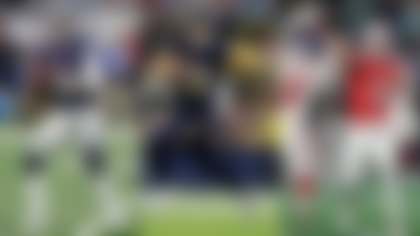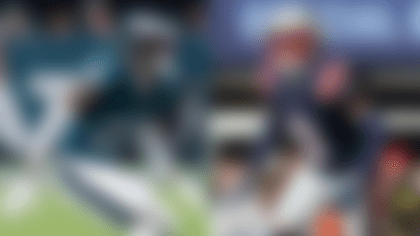Which teams got it right on fourth-down and two-point conversion calls in Week 16 of the 2021 NFL season -- and which teams got it wrong? The Next Gen Stats analytics team uses the Next Gen Stats Decision Guide powered by AWS to break down the numbers behind the decisions that shaped the game.

Sean McDermott and Bill Belichick make the optimal call every time on fourth down
In a pivotal AFC East matchup, McDermott (five) and Belichick (seven) combined to face 12 fourth-down decisions when the NGS Decision Guide gave a clear recommendation (i.e., the option increased the team's chances of winning by more than 1%). Both coaches were in alignment with the numbers all 12 times. We start with the victors ...
McDermott correctly went for it three times in the first half, converting for a first down on two of the three plays. The most consequential of the decisions came in the final minutes of the first half.
SECOND QUARTER: With 2:15 remaining, the Bills (leading 10-7) elect to go for it on fourth-and-2 from the Patriots' 34-yard line (following a 5-yard offside penalty on Patriots DT Christian Barmore on fourth-and-7). Josh Allen completes a pass to Stefon Diggs for 23 yards.
The offside penalty was a killer for New England. The 5-yard infraction turned a fourth-and-7 situation into a fourth-and-2, and in turn, increased Buffalo's chances of converting on the play by more than 16 percentage points (from 39.7% to 56%). When also considering the odds of making a field goal from either distance -- 30.3 percent at 57 yards and 46.5 percent at 52 yards -- and the value of kicking a field goal (three points) versus extending the drive (the possibility of six), going for it was the optimal call in any scenario. With 7 yards to go, we had the decision as a go for it by 1.1 percentage points. At 2 yards to go, that number increased to 1.3 percentage points. It did appear Allen and the Bills' offense intended to go for it on the longer down-and-distance even before Barmore jumped. It would have been the right call, as well.
Three plays after Diggs converted the first down, Allen found his favorite target once again for a 12-yard touchdown, ultimately giving the Bills a double-digit lead at halftime.
By keeping the drive alive, Buffalo took advantage of the game's "middle eight," a term used to describe the last four minutes of the first half and first four minutes of the second half. The Bills scored 10 unanswered points mostly in that window, running 23 offensive plays to the Patriots' six between the 3:10 mark in the second quarter and the 9:02 mark of the third quarter.
If the end of the first half goes down as the tipping point that eventually led to Buffalo's win, McDermott's decision to go for it on fourth-and-1 with less than five minutes left in regulation should be considered the game-clinching play.
FOURTH QUARTER: With 4:27 remaining, the Bills (leading 26-21) elect to go for it on fourth-and-1 from the Patriots' 34-yard line. Allen keeps and runs to the left end for 8 yards and a first down.
Out of the 10 fourth-and-short (4 yards or fewer) decisions from this game, none were more definitive than Buffalo's fourth-and-1 scenario in the game's closing stretch. The NGS Decision Guide had this as a strong go for it scenario: 9.2 percentage points in win probability value, to be exact. In this specific situation, we had the Bills converting for a first down 77.7 percent of the time, while a field goal from that range (52-yard attempt) is estimated to be made at a 47 percent rate in this scenario. Since a field goal did not create a two-possession lead for Buffalo, going for it was the unequivocal decision.
Despite losing the game, Belichick had his most optimal day on fourth down; the six-time Super Bowl champion head coach and the Next Gen Stats Decision Guide were finally in sync. Excluding two fourth-down situations in the final two minutes of the game -- when New England had less than a 1 percent chance of winning, according to our win probability model -- Belichick and the Patriots faced seven fourth-down decisions. Our numbers agreed with New England's move in each.
We previously highlighted how Belichick was conservative in Week 15's 27-17 loss to the Colts -- and across the 2021 season in general. This game was different. Belichick kept his offense on the field, when the numbers said that he should, four times in the game's first three quarters. The Pats coach netted 15.3 percentage points in expected win probability as a result of those decisions alone (agnostic of the outcome).
Across Weeks 1 through 15, Belichick made the optimal call by keeping his offense on the field a total of four times when our model recommended to go for it by more than 1 percent, doing so at the second-lowest rate in the NFL. Belichick and Co. made as many correct go for it calls on fourth down in the first three quarters alone on Sunday, converting for a first down on all four:
- 3:36 left in the first quarter, fourth-and-1 at New England's 48-yard line: Go for it by 4.9%
- 15:00 left in the second quarter, fourth-and-1 at Buffalo's 28 yard-line: Go for it by 3.7%
- 5:25 left in the third quarter, fourth-and-1 at Buffalo's 23-yard line: Go for it by 4.4%
- 3:02 left in the third quarter, fourth-and-3 at Buffalo's 10-yard line: Go for it by 2.3%

Sean McVay astutely keeps offense on the field on fourth-and-short
McVay's Rams are not exactly known as an aggressive team when it comes to fourth-down strategy. Entering Week 16, Los Angeles ranked 25th in optimal decision rate (32%) when the numbers said go for it on fourth down by more than 1 percent. That said, there is one area where the Rams have consistently gotten it right on fourth down this season: fourth-and-1 when our NGS ball-tracking data says the to-go distance is less than 1 yard. McVay has correctly gone for it in five of six situations when the numbers suggest keeping the offense on the field by more than 1 percent, including Sunday on the opening drive.
FIRST QUARTER: With 10:44 remaining and the game tied at 0-0, the Rams elect to go for it on fourth-and-inches from their own 49-yard line. Matthew Stafford fumbles and recovers the snap on the quarterback sneak, gaining 2 yards for a first down.
According to our NGS ball-tracking technology, the Rams had 0.6 yards to gain for the first down. Our model put the odds of converting at 81 percent in this situation. The NGS Decision Guide recommended going for it was the optimal call by 3.7 percentage points in win probability value. Stafford was able to gain enough yards for the first down despite fumbling the snap at the start of the play. Los Angeles would go on to score a touchdown on the drive, establishing an early lead that the Rams would never relinquish.
Follow the Next Gen Stats team on Twitter.














